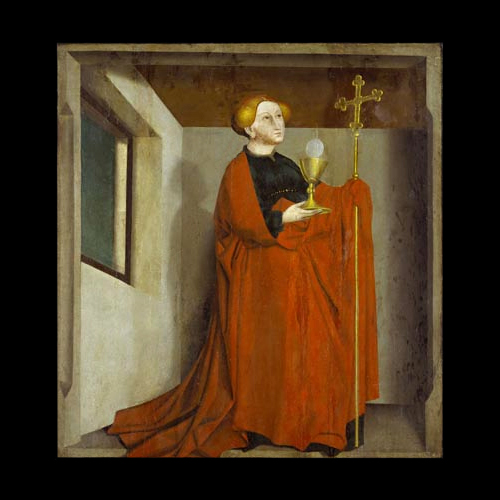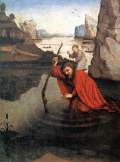Ecclesia also grasps her cross from under her scarlet robe; in her right hand she balances a chalice on which a single host is in turn balanced by divine funambulism. The square shape of the canvas – in Ecclesia and The Synagogue – helps reinforce the confined unreality of the two pictures. In The Synagogue, the yellow-robed figure has her eyes closed and the standard she carries is elegantly snapped off, unrealistically so, below the nib-like tip.
Konrad Witz 2: St. Bartholomew
The connection between Konrad Witz’s paintings and those of Francis Bacon, what makes the former modernistic and the latter classical in his execution, is the way they frame their subjects with planes and lines of perspective: both seek pictorial depth by playing with flatness. Witz’s St. Bartholomew (1435), Ecclesia (1435) and The Synagogue (1435) all cram their subjects into foreshortened rooms or alcoves where the picture surface is the fourth wall; pediments and columns of grey stone and plaster, their corners bevelled, look like modern reinforced concrete. A window, without glass or shutters, in each of the three canvases, seems impossibly angled. Witz is interested in the flat plane of colour (muted behind the vivid drapery), and in the way these planes hit off against each other. St. Bartholomew, curly-haired, bearded, simian, is holding a red-bound, gilt-edged Bible in his left hand, a knife in the other. The hidden hand clasps the knife from under his ornate, jewel-bordered vestment, as though Witz didn’t know how to do hands. The slight menace of this, the deep dramatic shadow cast behind him, as well as the rough paintwork of the face, remind me of other moderns – Magritte, Hopper.
Konrad Witz 1400-1445
Witz’s St. Christopher is a marvellous, dreamy canvas, as though the giant and the child float down the river of the unconscious. Concentric ripples tinged with red, green and white work their way out from the giant crossing the river running through a rocky landscape: the ripples bring perspective to the foreground and diffuse the light in haloes round the central iconic figures. The almost broken staff of the giant, signalling the unearthly weight of the Christ-child, parallels the line of the rock face and indicates the vanishing point. Staff, giant and child are triangulated in the centre of the canvas. Further up the imaginary river, the light is pale, more ethereal, a silvery blue crossed by silhouetted ferries and ferrymen. On the left bank a red-tiled church and cloister with a monk on the shore carrying an osier basket, just like Friar Lawrence in Romeo and Juliet: there’s a secondary triangular relationship between the hooded monk, similar size to the Christ child, and the red-cloaked giant: the child is father to the man, the giant’s strength is tested by the god-child, the monk is their extension in time. The bottom of the picture is all mud and reeds: deep umber river water. A ghostly reflection of the church is as yet undisturbed. Across the pellucid sky three birds – cranes? storks? – echo the triad beneath: monk, giant, child.






